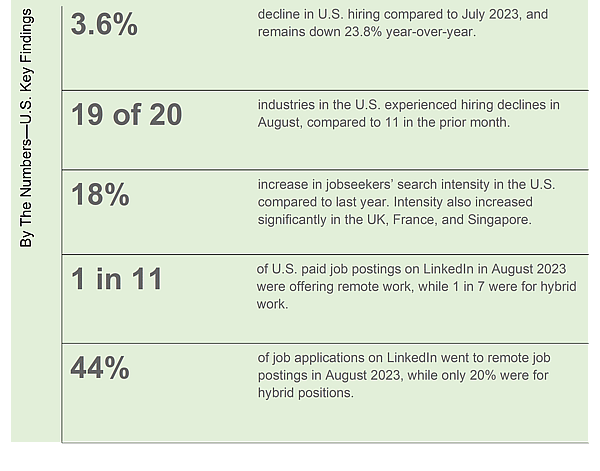While it is widely accepted that the apex of the COVID-19 pandemic is long behind us, the lasting effects of the 2020 outbreak are very much prevalent over three years later. In particular, the American perception of flexible work changed drastically as a result of social distancing mandates. Quarantine periods shut thousands of offices across the country. Employers that had previously required in-person attendance had to embrace a new era of work flexibility as a means of survival.
For some professionals, flexible work was not a new concept.
It’s common for sales professionals to travel to meet with clients and prospects outside of the office. Due to the nature of their roles salespeople were granted work flexibility in terms of where and when they worked.
In 2020, the combined impact of the COVID pandemic and the acceleration of digital technologies permanently transformed our perception of the workplace.
As home offices and work-from-home setups became commonplace employees and employers alike began to ask the question — will we ever go back to the way things were?
Flexible Work: A Tale of Two Perspectives
Remote, hybrid, and on-site. These three words have become essential components of job descriptions for any company seeking new talent. With its benefits for both employers and employees receiving a healthy dose of exposure and promotion thanks to pandemic-era media coverage, remote and hybrid arrangements have increased in popularity across nearly every major industry.
That said, employers and employees have shared remarkably different perspectives on the topic of workplace flexibility.
1. Employers
A multitude of factors must be taken into consideration before determining the working environment of their employees:
- Are the core products or services of the company best managed in-person or virtually?
- Does remote customer support improve or harm customer satisfaction?
- Does the role make sense in a remote setting?
- How will this impact shareholders?
- Will this help or hurt company culture?
2. Employees
The “flexibility” aspect of the equation impacts both the location of their role as well as the hours they choose to work. This is the origin of questions such as:
- Can I avoid the 45-minute commute to the city and instead dedicate
that time to meaningful work on my most important projects? - Will I be able to commit to driving the kids to school three days
per week and work later in the evenings from my home office? - Can I set my working hours?
With the discussion around flexible working environments seemingly evolving at a rapid pace, it can be difficult for both parties to find common ground. However, the data surrounding the issue seems to suggest that this intersection between employer and employee desires is paramount to the success of the flexible work model.
Earning Your Remote Stripes
During the initial stages of the COVID-19 pandemic, nearly every Fortune 500 company was promoting remote openings and their collective support for the work-from-home model.
More recently, a surge of return-to-office (RTO) campaigns have been launched by tech giants such as Meta (Facebook), Google, Amazon, and even Zoom – the video conferencing platform known for pioneering the remote work movement in early 2020.
Big tech wasn’t the only industry to flip the script on remote work — Goldman Sachs has begun mandating in-person attendance five days per week. While real estate firm Redfin announced all employees who live within a 20-mile radius to its offices must return to work in-office on Tuesdays and Wednesdays.
These changes have come to the dismay of thousands of employees who gained substantial value from their remote schedules. With fewer and fewer opportunities for remote and hybrid work appearing on job sites such as LinkedIn and Indeed, the competition for the remaining roles has spiked dramatically.
Demonstrating productivity is the best weapon employees have when attempting to justify the value of their remote work schedule. Employees who want to work from home will need to prove they are doing what’s necessary to help their company deliver its product or service to customers and increase or maintain the value they bring to the company for its shareholders and fellow employees.
Eight Negotiable Benefits to Consider In Lieu of Salary
Measuring Productivity and Sharing Space
The expression “if you can’t measure it, you can’t manage it” summarizes one of the biggest pain points for employers evaluating flexible work environments today. Without the ability to measure performance in some capacity, managers have no visibility into the productivity of their workers or the efficiency of the remote model.
Many employers have turned to employee monitoring software to gain insights into these areas. Due to the presence of said programs, employees must be extra diligent when managing their remote workloads. By inviting corporate technology into their homes that can monitor project progress and work duration, employees are sacrificing what was once their personal space for the ability to work remotely.
Employee output and quality of work are still vital indicators that employers will continue to use to determine performance. However, measuring performance by output alone is no longer a reliable practice in the age of remote work.
The idea of shared or commingling space between an employee and their employer also has the potential to bring about scheduling conflicts, along with a laundry list of new employer justifications.
If an employee no longer has to spend time commuting to and from the office, an employer may request that they remain available and responsive during those periods.
If a manager-level worker is working on a weekend, they may feel more inclined to call one of their direct reports to assist on a project as they usually would throughout the week, as the lack of face-to-face interaction makes virtual communication seem more and more like an on-demand service.
The ethics of these practices and justifications are up for debate, but one thing is for certain — the lines in the sand that once defined the concept of work-life balance have become blurred for those seeking work flexibility.
Striking a Balance for Retention
Finding the right balance to make work flexibility “work” is a tightrope act that many employers are currently attempting to get the most out of the model’s value.
In many ways, flexible work models are a series of constant battles. They pit flexibility against performance, privacy against visibility, and innovation against reliability. Employers who can strike the perfect balance between these polarizing forces will see the best results and the highest levels of appreciation from their employees.
Employees that find a company who have mastered the remote work ecosystem are not going to be quick to throw away that opportunity, especially when they are entering a time in their lives when they are focused on career and financial advancement.
Alternatively, employers who strong-arm their employees into returning to the office or companies that enact RTO policies for ulterior motives are far less likely to retain top employees.
Major financial institutions that have a stake in the performance of commercial real estate properties have attempted to generate demand for said properties themselves. In other words, by forcing their employees to return to the office in a highly publicized fashion, these institutions hope that other firms will be more likely to return to the office and seek commercial rentals.
How Daley And Associates Can Help Your Staffing Needs
To Flexible work, or Not to Flexible work?
The widespread adoption of remote work has transformed the modern workplace. Employees, having experienced the flexibility and autonomy that comes with working from home, have voiced a clear preference to maintain this mode of working — the desire for work from home is here to stay. This shift marks a significant change in corporate culture and employee expectations, indicating that the desire for work-from-home options is not just a temporary trend, but a fundamental shift in how people wish to balance their professional and personal lives.

LinkedIn data shows that 43.7% of job applicants analyzed in the study wanted 100% remote positions, while another 20.3% wanted hybrid roles. That’s 64% — two-thirds of all applicants — requesting work flexibility. So when the time comes for employers to decide on remote work, whether it be for a single role, a team, a department, or an entire company – what are the most critical boxes to check before making the final call?
The nature of the industry and the job function in question are the two items at the core of this question. If your company’s products, services, customers, levels of innovation, and shareholders are not negatively impacted by a remote or hybrid working environment, there are plenty of cost-saving and retention benefits to support work flexibility.
Embracing the Future
In the end, the “common ground” or meeting of the minds between employers and employees will ultimately dictate the future of the model.
Employees will have to accept and understand the expectations of personal productivity, accountability, and shared working spaces. Employers, on the other hand, will need to embrace the needs of individual employees who are seeking this relatively new employment environment to maximize their potential, in turn maximizing their output.
The flexible work model has the potential to help companies outpace competitors who fail to adapt to the changing climate of the talent market.
If you are interested in learning more about hiring quality remote candidates or are looking for your next remote or hybrid career opportunity, connect with Daley And Associates today to speak to one of our team members.




